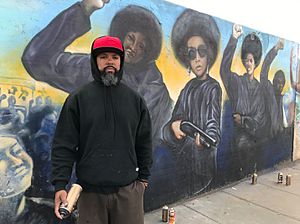Destination Crenshaw facts for kids
 |
|
| Established | 2019 |
|---|---|
| Location | Crenshaw Boulevard, Hyde Park, Los Angeles |
| Type | History and culture of African Americans |
| Architect | Zena Howard, (Gabrielle Bullock, managing principal) Perkins+Will |
Destination Crenshaw is a special outdoor museum built in Los Angeles, California. It stretches for about 1.3 miles (2.1 kilometers) along Crenshaw Boulevard. This unique project is all about celebrating and preserving the rich history and culture of African Americans. It features new small parks, amazing outdoor sculptures, colorful murals, cool street art, and beautiful plants. The project began in 2019 and officially broke ground in February 2020.
What Does Destination Crenshaw Look Like?
The design of Destination Crenshaw features four main areas, called "nodes," along its path. Each node has a special theme that celebrates the African American art and heritage of the area.
Sankofa Park: A Place to Look Back and Forward
The northernmost part of the project is Sankofa Park. This large new public park is right next to the Leimert Park Metro station. The park features a Sankofa bird symbol. This bird looks backward while its feet face forward, holding a precious egg. It reminds us to learn from the past while moving into the future. Visitors to the park can enjoy views from a raised platform. You can see sculptures by famous artists like Charles Dickson, Maren Hassinger, Artis Lane, and Kehinde Wiley here. Nearby, Leimert Plaza Park has long been a center for African American art and culture in Los Angeles.
Dreams and Inspiration at 50th Street
The second main area is located near Crenshaw High School at 50th Street. Its theme is "Dreams." This part of the project was inspired by Paul Revere Williams, a local African American architect who lived from 1894 to 1980. A sculpture by Alison Saar in this area was inspired by her memories of her mother, artist Betye Saar, shopping nearby.
The Crenshaw Wall: A Canvas of History
"The Crenshaw Wall" is a very important part of the project. It has an existing mural called "Our Mighty Contribution." This mural, painted in 2000, shows thousands of years of Black history, starting with the words "In the beginning." The wall, which is about 800 feet (244 meters) long, has been a place for murals and graffiti art celebrating Black culture and social messages since the 1960s. A new mural, "The Struggle Continues," reimagines and expands on these themes.
Firsts and New Beginnings at 54th Street
The third main area, themed "Firsts," is around 54th Street. It includes new small parks. Artist Melvin Edwards created a work here, remembering his first sculpture ever shown nearby in 1963.
I AM Park: A Powerful Statement
The southernmost part of the project is I AM Park at Slauson Avenue. A work by Brenna Youngblood was one of the first pieces placed here. The initial idea for this end of the project included a 120-foot (37-meter) tall monument that spells out "Crenshaw" in giant letters.
The Architects and Artists Behind the Project
The design firm for Destination Crenshaw is Perkins and Will. Architect Zena Howard has over 25 years of experience creating projects that honor Black history. She calls her work "remembrance work." Some of her past projects include the National Museum of African American History and Culture and the Motown Museum expansion. The construction of Destination Crenshaw was planned to finish within a year of its groundbreaking in February 2020. However, it faced delays due to the COVID-19 pandemic. The museum will feature 100 permanent and temporary public artworks.
Why Was Destination Crenshaw Created?
The Crenshaw district, Hyde Park, and Leimert Park are known as the "heart of African American commerce in Los Angeles." Destination Crenshaw was created to celebrate this area as a strong Black community. There were worries about gentrification (when an area changes and becomes more expensive, sometimes pushing out long-time residents) because of the new K Line light rail and the NFL Stadium in Inglewood.
Protecting Community Identity
This project aims to keep the community's unique identity. It celebrates being "unapologetically, authentically black." Just like Koreatown, Chinatown, and Olvera Street have their own identities, supporters wanted Destination Crenshaw to highlight the history of South Los Angeles.
Community Involvement and Support
Marqueece Harris-Dawson, a Los Angeles Council member, worked closely with the neighborhood on this project. He brought together many leaders from South Los Angeles. These included artists, activists, curators, musicians, filmmakers, and community organizers. Famous people like Issa Rae, who grew up in the area, spoke at the groundbreaking ceremony in February 2020.
Addressing Community Concerns
Local business owners and residents were concerned that the new light rail trains, running at street level, would remove important parking spaces. A fence along the train tracks also created a barrier for small businesses. To help, the project has supported local businesses with grants for improvements. These grants helped with building repairs, new parking spaces, and culturally designed sidewalks. Contractors working on the project were also required to hire workers from groups that are often underrepresented in the trades. The plan is to add 100 artworks by new and established artists by 2027. Many local artists are part of this project.
Funding the Project
Destination Crenshaw is a $100 million project. It has received money from the City of Los Angeles, the State of California, and Los Angeles County. The Los Angeles County Metropolitan Transportation Authority (Metro) approved $15 million for Sankofa Park. Metro was already responsible for improving sidewalks and curbs after the K Line construction. The Getty Foundation also gave $3 million in grants for the first seven sculptures, covering artist fees, creation, and care. Steve Ballmer and DeMar DeRozan also helped raise money for the project. In July 2022, U.S. Transportation Secretary Pete Buttigieg visited, highlighting how the project would benefit from the Infrastructure Investment and Jobs Act. As of August 2025, a significant portion of the $100 million goal has been raised.
See Also


